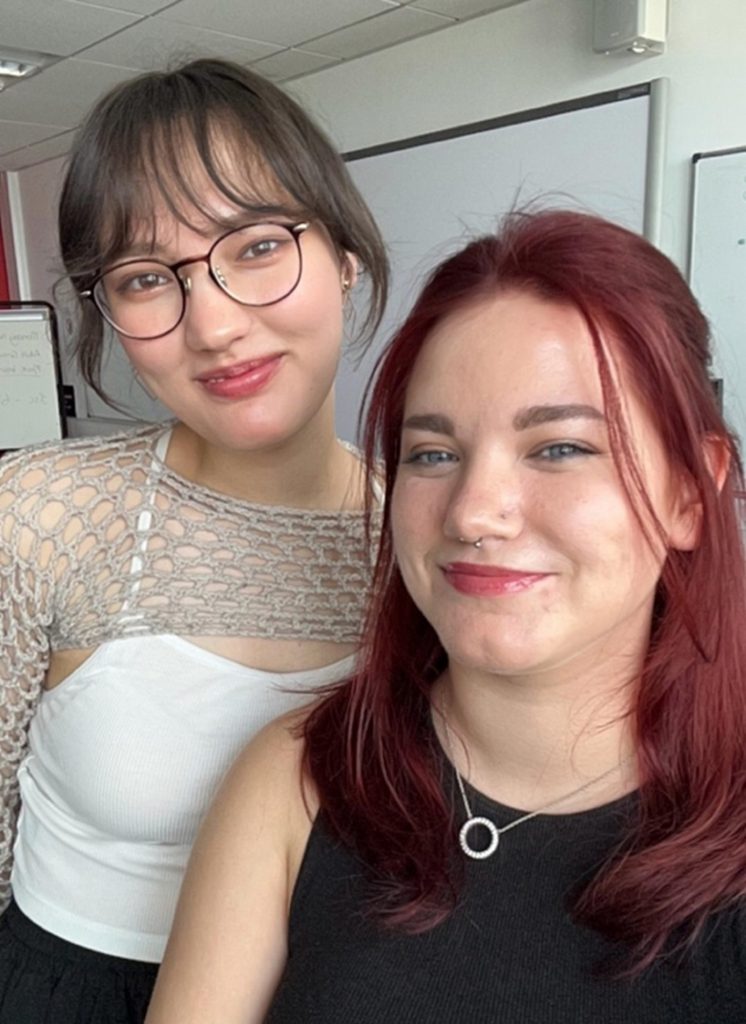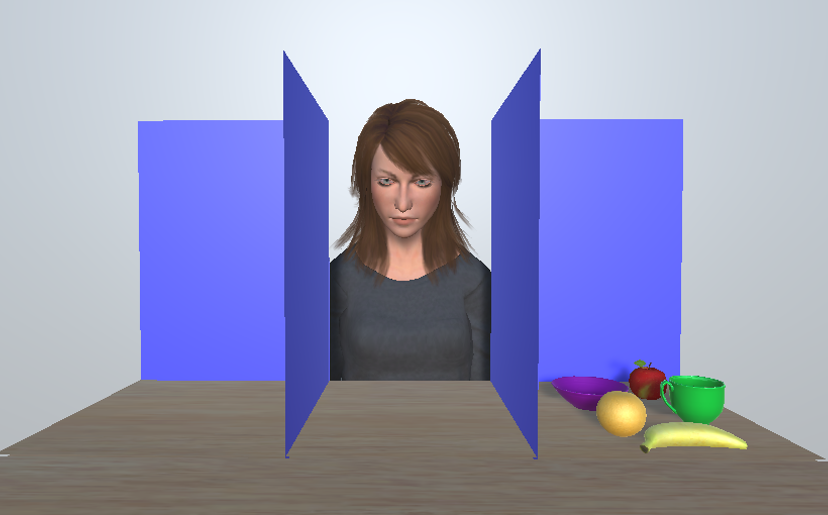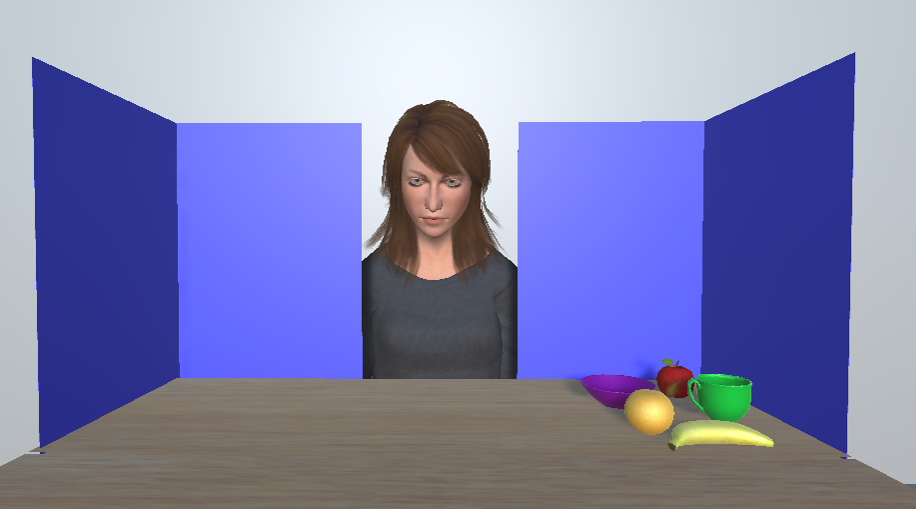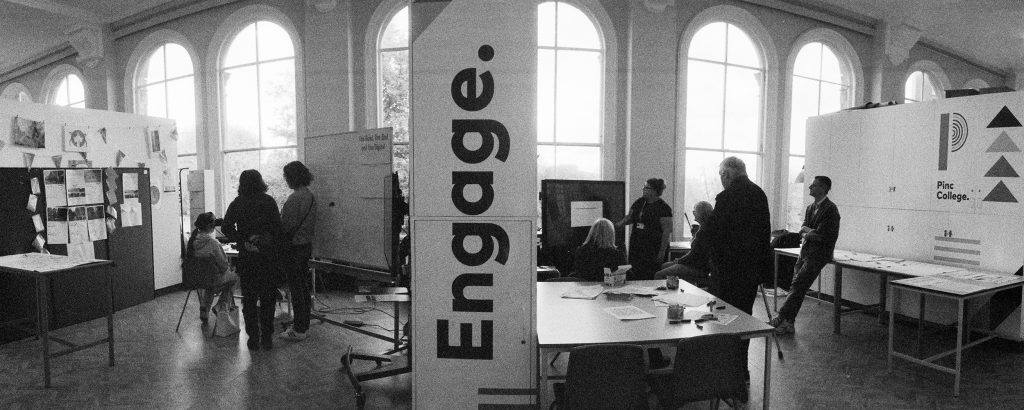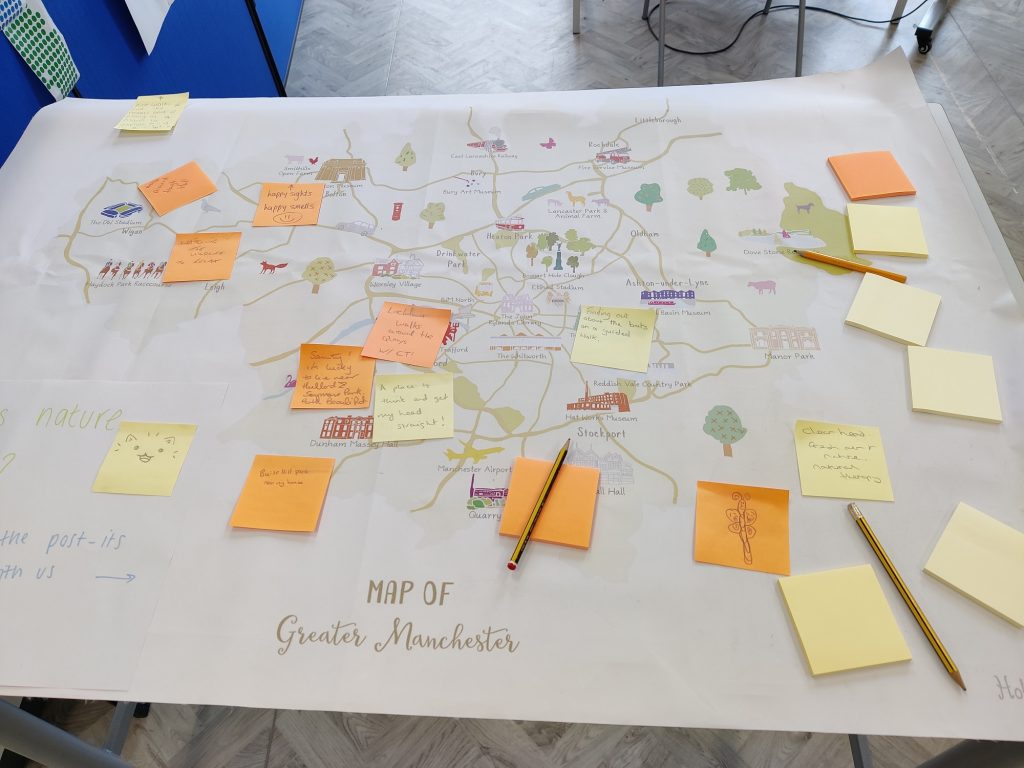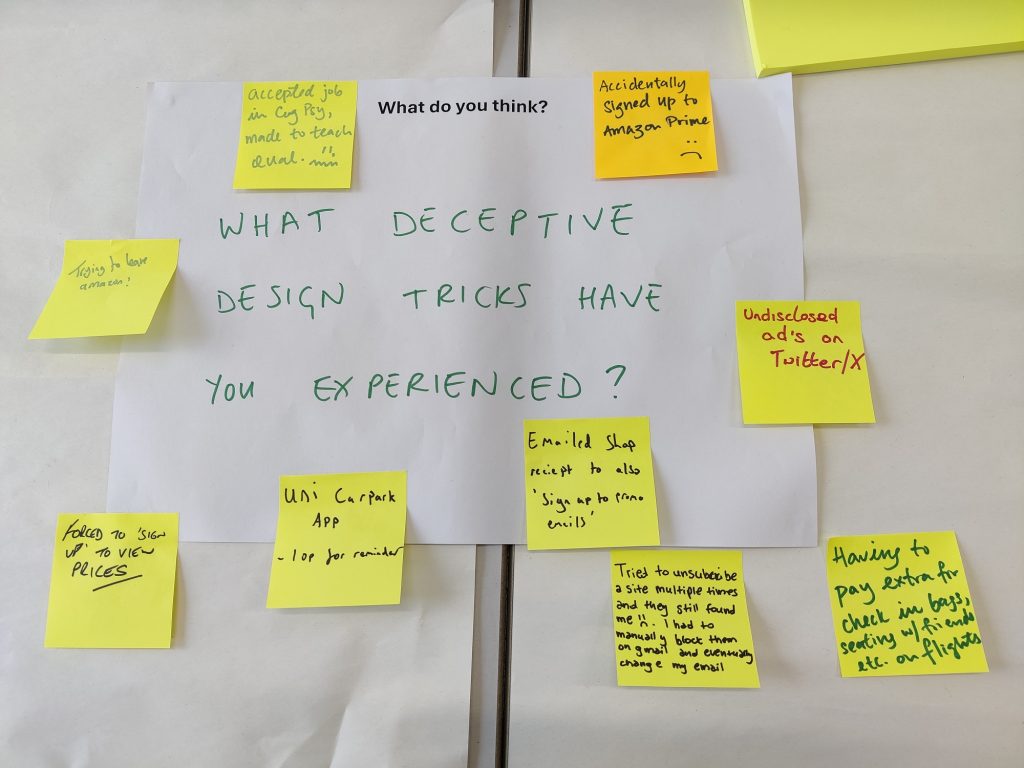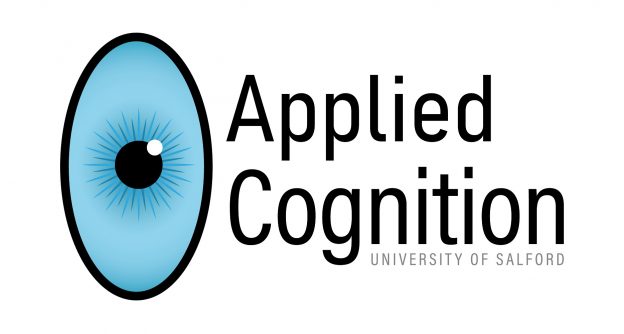On June 7th 2024 we are hosting the North West Visual Cognition Group at an all day research event. At the event we will share our current research and foster new collaborations. Please see the abstracts below.
Using mobile eye tracking to investigate the psychological benefits of an urban green space in central Manchester
Dr Catherine Thompson, Momina Ijaz, and Neil Harrison
The psychological benefits of spending time in nature are well-documented, with many studies showing improvements to mood, enhanced wellbeing, and attention restoration. Efforts to understand and explain the advantages of engaging with nature, particularly in densely populated urban areas, are becoming increasingly important as more people live in urban environments with limited access to green space. This study investigates the psychological impact of spending time in the Castlefield Viaduct, a National Trust site in the centre of Manchester. Described as a ‘sky garden’, the site is a Victorian Grade-II listed railway viaduct that has been transformed from a derelict space into a green oasis. Visitors (so far data has been collected from >25 participants) complete short questionnaires about their mood and their connectedness to nature, and then they explore the Viaduct while their eye movements are recorded using mobile eye tracking glasses. After their visit, they complete the same questionnaires again and a questionnaire measuring perceived restorativeness of the space. Positive and negative emotion and nature connectedness will be compared pre- and post-visit to assess the benefits of spending time in the Viaduct. Viewing behaviour will also be correlated with nature connectedness and perceived restoration and this analysis will contribute to knowledge regarding the mechanisms through which psychological restoration occurs. The research may provide empirical evidence for the psychological benefits of urban greening that can be used by the National Trust and other organisations to support the design and creation of future green-space initiatives.
The impact of interior space design on incidental memory
Nooshin Momenzadeh, Tobiasz Trawinski, Letizia Palumbo
It has been demonstrated that there is preference for interior designs based on their aesthetic and space features [1], [2]. This study examines whether interior design preference can predict incidental memory performance in relation to participants personality traits.
To select the stimuli, in the first experiment 26 participants rated 114 pictures of interior designs on ceiling height (low vs. high), space openness (enclosed vs. open), appearance (rectilinear vs. curvilinear), and distinctiveness. In the second experiment, 40 participants rated 40 pictures on a scale from 0 (dislike) to 100 (like). Following, participants completed an incidental memory block with additional 40 new pictures, indicating whether they had seen or not seen each picture before. Participants completed the Desire for Aesthetics Scale [3] (DFAS), the Openness to Experience and Extraversion scales of the Big Five Aspect Scales [4].
Linear Mixed Effects Models revealed that higher scores in DFAS, high ceiling, open space, and rectilinear appearance significantly predicted a higher preference for interior environments. The incidental memory performance was significantly influenced by the longer viewing duration in the first block. The experiment was repeated in the laboratory with slightly different results which are discussed in relation to the links between preference and cognitive performance for interior spaces.
[1] L. Palumbo, G. Rampone, M. Bertamini, M. Sinico, E. Clarke, and O. Vartanian, “Visual preference for abstract curvature and for interior spaces: Beyond undergraduate student samples,” Psychol. Aesthet. Creat. Arts, vol. 16, no. 4, pp. 577–593, 2022, doi: 10.1037/aca0000359.
[2] O. Vartanian et al., “Impact of contour on aesthetic judgments and approach-avoidance decisions in architecture,” Proc. Natl. Acad. Sci., vol. 110, no. supplement_2, pp. 10446–10453, Jun. 2013, doi: 10.1073/pnas.1301227110.
[3] D. E. Lundy, M. B. Schenkel, T. N. Akrie, and A. M. Walker, “How important is beauty to you? The development of The Desire for Aesthetics Scale,” Empir. Stud. Arts, vol. 28, no. 1, pp. 73–92, 2010, doi: 10.2190/EM.28.1.e.
[4] C. G. DeYoung, L. C. Quilty, and J. B. Peterson, “Between facets and domains: 10 aspects of the Big Five,” J. Pers. Soc. Psychol., vol. 93, no. 5, pp. 880–896, Nov. 2007, doi: 10.1037/0022-3514.93.5.880.
Vision for action after sight restoration from congenital cataracts
Dr Irene Senna
Could individuals who were born blind but gained sight through surgical intervention learn to integrate vision with other senses to perceive and interact with their environment? To address this question, we studied perceptual and visuomotor development in Ethiopian children and adolescents who underwent surgical treatment for congenital dense bilateral cataracts several years after birth. In this presentation, I will discuss two studies assessing their ability to use vision for action. In the first study, we investigated their capacity to recalibrate their sensorimotor system once an optical distortion is introduced. Participants performed a pointing task while wearing prismatic goggles shifting the apparent location of the target. While their sensorimotor recalibration performance was impaired right after surgery, it showed some gradual improvement within a few years after surgery. In the second study, we tested whether they could use visually estimated object properties to make predictions for feedforward control of grasping. Participants were asked to repetitively grasp equally weighted objects differing in size. Unlike typically sighted controls, cataract-treated participants did not learn to adjust grip force and hand aperture to the visually estimated object size even years after surgery. These findings suggest that while certain aspects of action development occur, others may remain underdeveloped. On one hand, the partial development of recalibration abilities highlights the importance of sensorimotor experience, even when acquired later in life. On the other hand, the apparent impairment in the ability to rely on visually estimated object properties to pre-program actions suggests that structured visual input during early developmental stages may be crucial for the full development of action planning capabilities.
Aesthetic cognition: the role of an emotional relationship with the natural world in the processing of visual stimuli in nature environments
David Beevers
The ability of nature to restore psychological resources is well-established. However, most research into the visual appeal of nature has focused on the objective assessment of a nature environment in terms of content, with less emphasis on the subjective perception-based assessment by the observer. The objective assessment of an environment’s visual aesthetic quality is expert-based and reliant on the observer assessing the scene using their knowledge of nature settings they have previously viewed. Based on this knowledge of nature, they isolate and identify the elements which they regard as most appealing. In contrast, a perception-based assessment sees environmental value as a product of the human mind. It is not a top-down knowledge-based assessment, but rather a bottom-up emotional reaction to the scene. Subjective responses are either a direct and immediate aesthetic sensory reaction or are indirectly generated through other personal cognitive constructs such as individual interpretations of mystery, legibility, and compatibility. Further exploration of the role of aesthetic cognition in the visual processing of nature environments may be important in understanding the psychological benefits of engaging with nature.
The effect of social and non-social cues on attention and working memory in a busy visual environment
Dr Samantha Gregory
Sharing attention, i.e. looking at objects together, leads to beneficial processing of objects under shared gaze, this is sometimes termed joint attention. Using social gaze cues, it is found that jointly attended objects are liked more, processed quicker, and remembered better in both long term and working memory. Interestingly, non-social arrow cues show similar effects on attention to gaze cues, but do not affect how much objects are liked or remembered. However, these tasks are often conducted using very simple displays where information appears in only one location in a screen-based task, yet the real world is cluttered. Therefore, we need to understand how social and non-social cues impact attention and subsequent working memory in a cluttered environment. Here I will present a series of studies investigating the effects of social gaze cues as well as non-social arrow and motion cues on attention and working memory in more cluttered target displays where task relevant information occurs on both sides of the attention cue. Results will be discussed in relation to cue purpose.
Keynotes
KEYNOTE 1.
The effects of visual impairment on sensorimotor control: the efficacy of second-eye cataract surgery
Dr Rachel Coats, – University of Leeds
The incidence of visual impairments increases with age. Cataracts offer a common, real-life example of a visual impairment that affects sensorimotor function. Although cataract surgery is cheap, it costs the NHS millions due to its high prevalence, causing restricted access to second-eye cataract surgery within the UK (to save money) and leaving people with one blurred eye. Critically, due to limited research on the impact of this kind of visual impairment on visuomotor skills, decisions to remove cataracts are currently based on arbitrary and geographically variable visual thresholds. We want to improve NHS protocols on recommending cataract surgery by studying the effects of cataracts/blurred vision on visual and motor function and support the development of more effective, data-driven assessment and intervention protocols. I will present recent data from our labs looking at the effects of blurred vision on visual function, heading perception and prehension, and discuss future study plans.
KEYNOTE 2.
Acting by looking: Gaze control in the context of assistive communication
Dr David Souto, University of Leicester
The last twenty years or so have seen the development of gaze-controlled computer interfaces for augmentative communication and other assistive technologies. In many applications, users need to look at symbols on an on-screen keyboard and maintain their gaze to make a selection. A major challenge, known as the “Midas touch” problem, arises because users must suppress the natural tendency to look for its own sake. We don’t normally look to act upon the world but to acquire visual information. This raises questions about how individuals learn use gaze to operate an interface and how this compares to learning a new control mode using our hands, such as selection by hovering rather than pointing. I will present evidence showing the difference between those two types of control and how learning takes place. I will then present an ongoing project seeking to understand how this type of research can inform the design of novel interfaces through various kind of consultations with stakeholders. I will end with some thoughts on the challenges and rewards of doing research that attempts to address practical needs.
